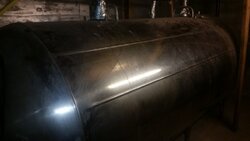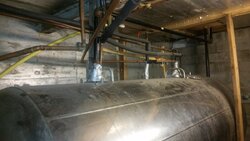My wife and I recently bought a house that came with an EKO 80 installed in 2008 with a 1500 gallon storage system. Previous owner said he ran the system last year with no problems and that it was ready to go for this year. I bought ten cord of oak and have been cutting that up, but reading on here I have quite a few questions and I hope someone can help.
The wood isn't totally dry, is this ok to still burn?
After reading a bit on here I decided to tear into the boiler a little bit and it seems like the damper would never fully close. The lever to clean the exchange tubes will not move. The top of that chamber was totally filled with ash (picture included) and I'm not sure how to clean it more.
I don't see any "nozzles" between the chambers, are those the holes in the sides of the firebricks? They are also filled with ash. How do I clean them?
One of the fans vibrated and broke off, it has been welded back on, is this going to be ok?





I'm afraid to fire up the boiler because it looks routine maintenance has been lacking and I don't want to hurt or damage the boiler. We have fuel oil for a backup so I can burn that this year if needed.
Thank you for your help in advance. I'm sure I'll have more questions as I go.
The wood isn't totally dry, is this ok to still burn?
After reading a bit on here I decided to tear into the boiler a little bit and it seems like the damper would never fully close. The lever to clean the exchange tubes will not move. The top of that chamber was totally filled with ash (picture included) and I'm not sure how to clean it more.
I don't see any "nozzles" between the chambers, are those the holes in the sides of the firebricks? They are also filled with ash. How do I clean them?
One of the fans vibrated and broke off, it has been welded back on, is this going to be ok?





I'm afraid to fire up the boiler because it looks routine maintenance has been lacking and I don't want to hurt or damage the boiler. We have fuel oil for a backup so I can burn that this year if needed.
Thank you for your help in advance. I'm sure I'll have more questions as I go.
Last edited by a moderator:





